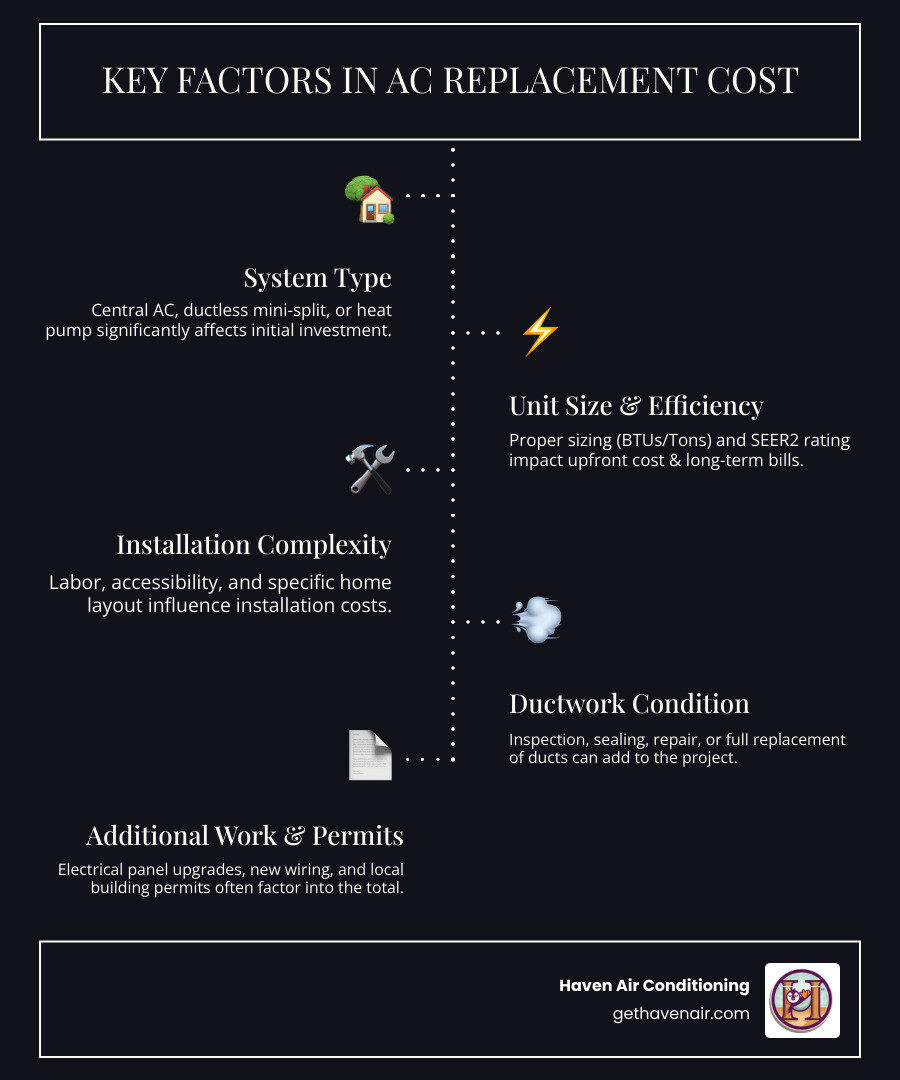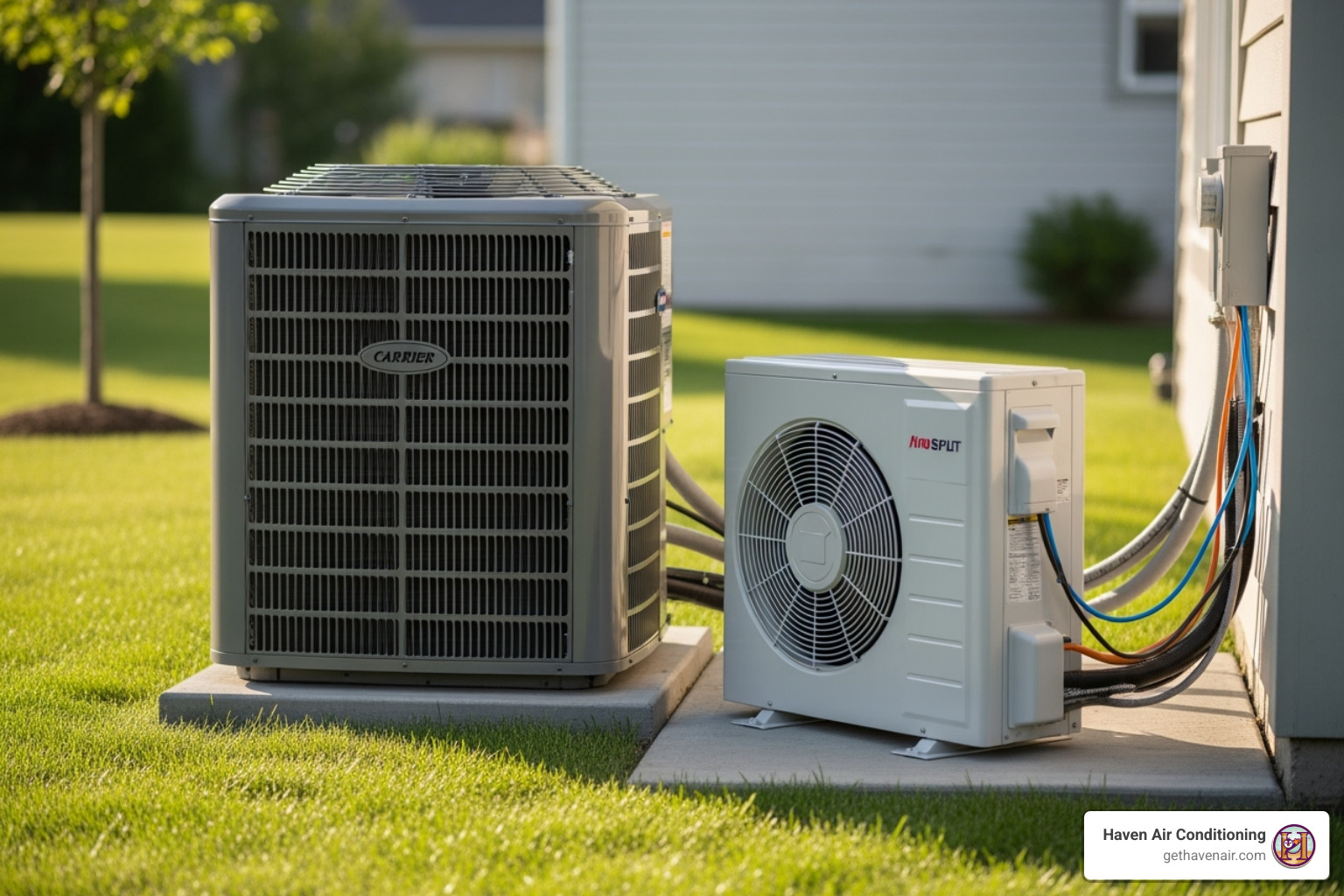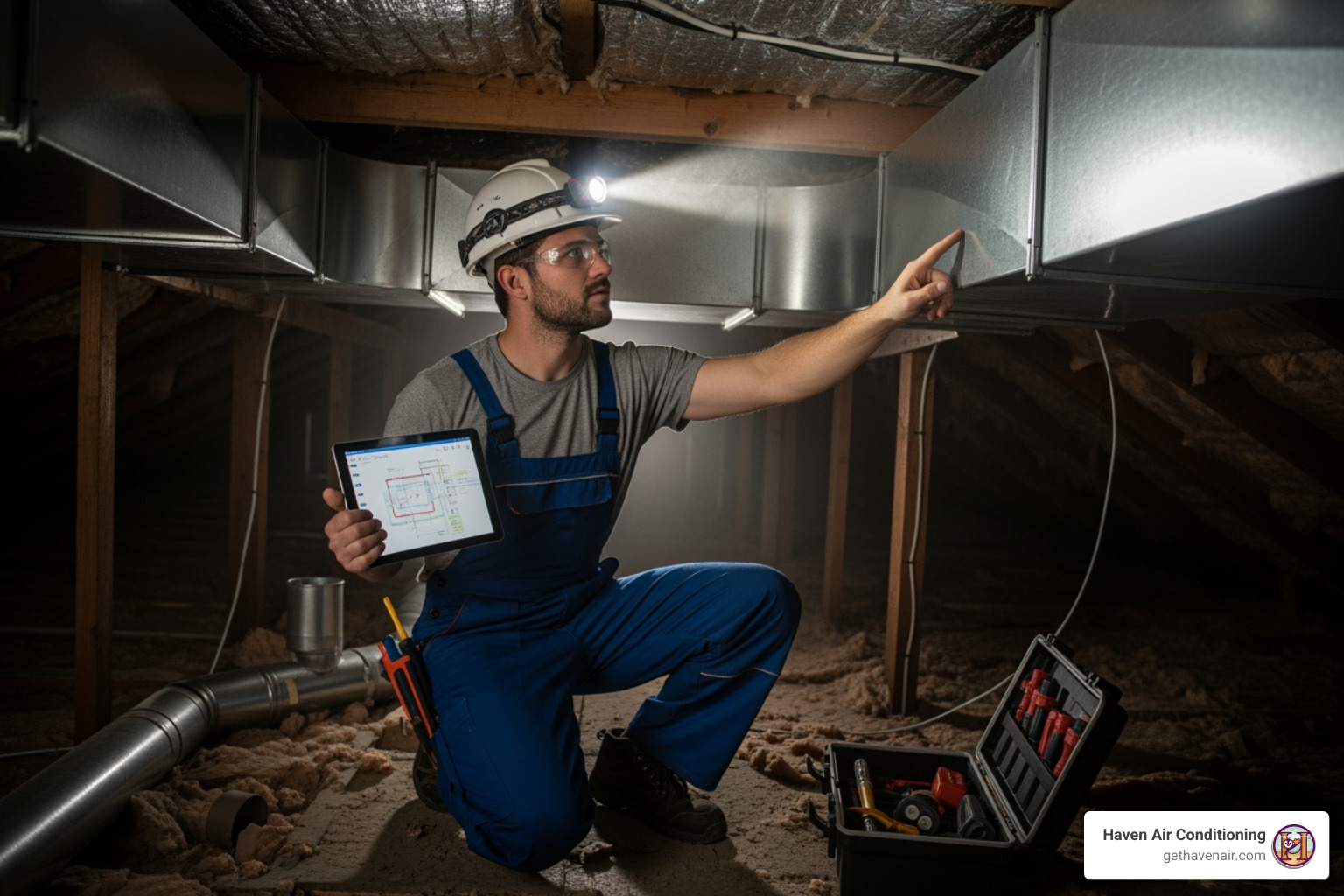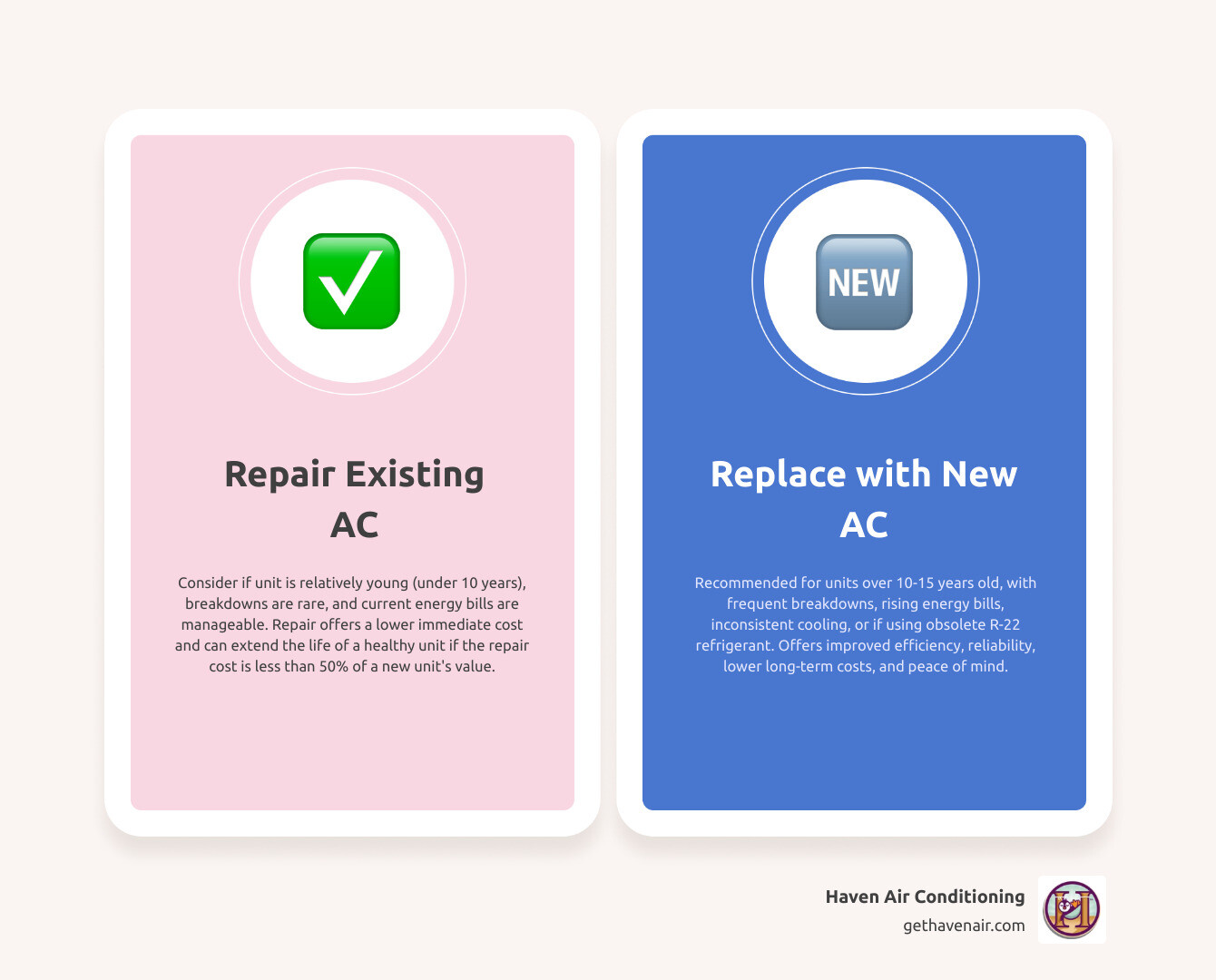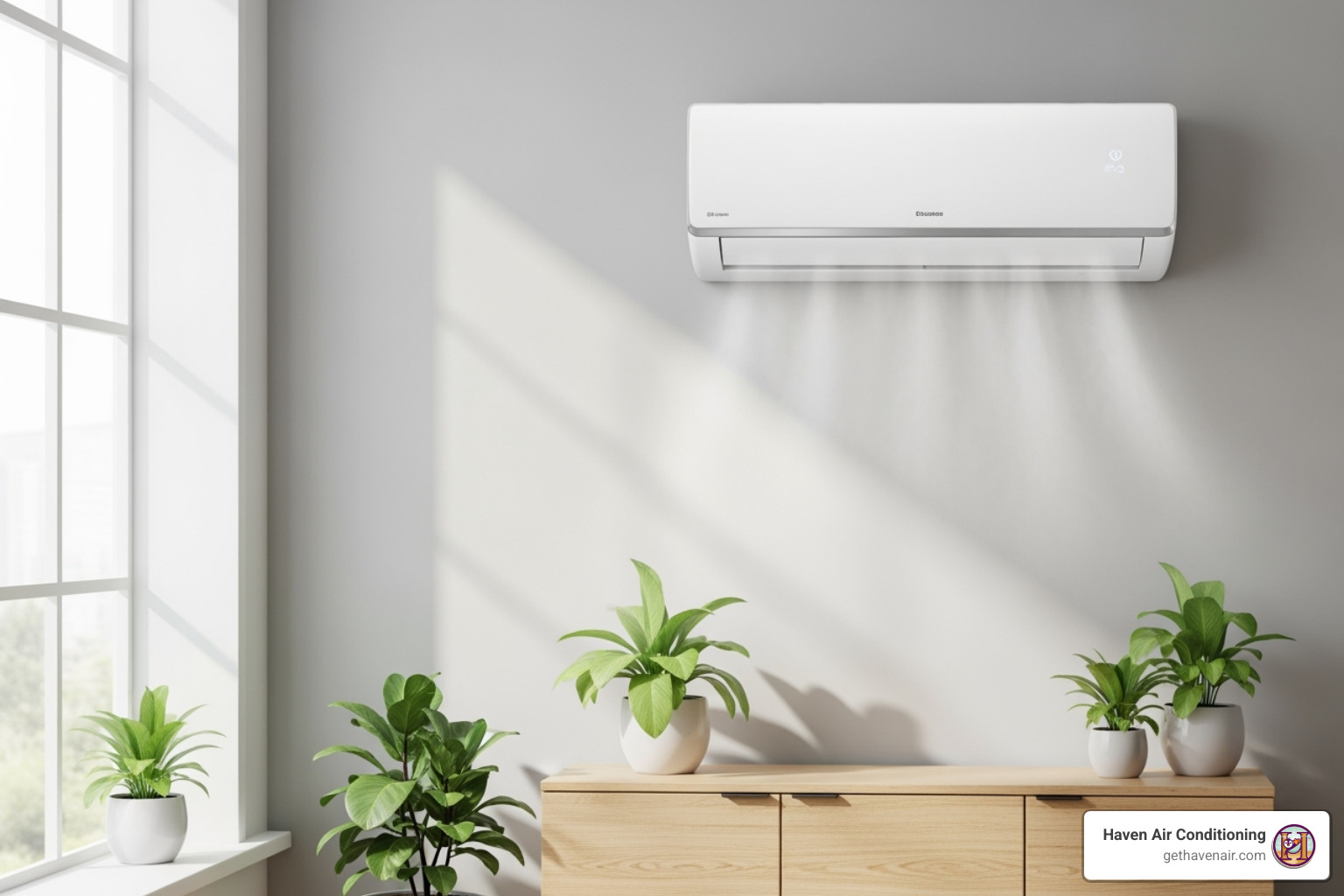The Main Drivers of Your AC Replacement Project
#
When your air conditioner fails, especially during a heatwave, the AC replacement cost can be a major concern. It’s a significant decision, and you want to get it right.
To help you understand the overall investment, here are the key factors that shape the cost of your AC replacement:
- Type of System: Central AC, ductless mini-split, or heat pump.
- Unit Size & Efficiency: Measured in tons and by its SEER2 rating.
- Installation Complexity: This includes your home’s layout and where the unit goes.
- Ductwork Condition: Does it need repairs or full replacement?
- Additional Work: Electrical upgrades or permits.
- Brand & Model: Different manufacturers offer various tiers of equipment.
Understanding these factors will help you feel confident about your choices.
The type of system, its size, and its energy efficiency are the foundational elements that largely determine your project’s scope and long-term value. Let’s explore these primary drivers.
How System Type Affects the Overall Investment
Choosing the right AC system is a major decision that impacts the initial AC replacement cost and your long-term comfort.
- Central Air Conditioners: The classic choice for whole-home cooling, these systems use a duct network to distribute air. If you have existing ductwork, installation is often straightforward, providing uniform cooling throughout your home.
- Ductless Mini-Split Systems: These systems offer personalized comfort with individual indoor units. They are a versatile solution for homes without ductwork, for additions, or for creating specific cooling zones. While the initial investment can be higher, their zoned cooling often leads to long-term energy savings.
- Heat Pumps: These highly efficient systems provide both cooling in the summer and heating in the winter by moving heat rather than generating it. They offer year-round comfort and represent a smart long-term investment.
The condition of your ductwork is key. A good duct system makes central AC a natural fit. For homes without ducts or those needing zoned cooling, a mini-split or heat pump is often a better long-term solution.
Sizing and Capacity: Matching the Unit to Your Home
Properly sizing your new AC unit is crucial. An improperly sized unit leads to comfort issues, premature wear, and higher energy costs. AC capacity is measured in tons, but a simple square-footage rule isn’t enough. We calculate the precise “AC load” for your home, considering factors like:
- Insulation, windows, and home construction
- Home orientation and sun exposure
- Number of occupants and heat-generating appliances
Why is this so important?
- Oversized units: An AC that is too large will “short cycle,” cooling the space too quickly and shutting off frequently. This causes premature wear, poor humidity control, and higher energy bills.
- Undersized units: An AC that is too small will run constantly, struggling to cool your home on hot days. This results in discomfort, excessive wear, and skyrocketing energy bills.
A professional load calculation is the only way to ensure the correct AC capacity. While tools like our AC Size Calculator offer an initial idea, an expert assessment is essential for a comfortable, efficient, and long-lasting system.
Energy Efficiency: The Role of SEER2 Ratings
An AC unit’s efficiency is measured by its SEER2 (Seasonal Energy Efficiency Ratio 2) rating. Like MPG for a car, a higher SEER2 rating means greater energy efficiency and lower electricity consumption. You can learn more at Understanding SEER2 ratings.
Here’s why SEER2 ratings are a crucial factor in your AC replacement cost:
- Upfront Investment: Units with higher SEER2 ratings have a higher initial purchase price due to more advanced technology.
- Long-Term Savings: A more efficient unit significantly reduces monthly energy bills, especially in a warm climate like Orange County. The long-term savings often provide an excellent return on the initial investment.
- Environmental Impact: A high-efficiency unit also reduces your home’s carbon footprint.
While regulations mandate a minimum SEER2 rating, we often recommend higher-rated units to maximize long-term savings. Our experts can help you balance the initial AC replacement cost with ongoing operational savings.
Beyond the Unit: Additional Factors That Shape Your Project
Replacing an AC unit involves more than just the equipment. Several “behind-the-scenes” elements related to your home’s specific characteristics can influence the overall AC replacement cost and ensure your new system operates safely and efficiently.
The State of Your Home’s Ductwork
Your ductwork is the delivery system for your AC. Its condition can significantly impact performance and your total AC replacement cost.
- Leaks and Holes: Leaky ducts waste a significant amount of cooled air, leading to higher energy bills and reduced comfort. Sealing these leaks is crucial for efficiency. Learn more about Duct sealing benefits.
- Poor Airflow: Old or poorly designed ductwork can restrict airflow, forcing your new AC to work harder. This causes premature wear and inconsistent temperatures.
- Duct Repair vs. Replacement: We thoroughly inspect your ductwork. Simple repairs may be enough, but severely damaged or improperly sized ducts may require full replacement. While this adds to the upfront cost, it’s a vital investment for peak performance.
Ignoring ductwork issues means you won’t get the performance you paid for. We ensure your entire system is optimized for maximum comfort and efficiency.
Installation Complexity, Permits, and Electrical Needs
A professional installation is a meticulous process that adheres to strict safety and building codes. This complexity, along with permits and electrical work, contributes to the overall AC replacement cost.
- Labor Considerations: Labor is influenced by factors like the accessibility of the indoor and outdoor units. An attic installation, for example, can be more complex and time-consuming.
- Local Building Permits: Most HVAC replacements in Orange County require local building permits to ensure the installation meets safety codes. We handle the entire permit process for you.
- Electrical Panel Upgrades: New, high-efficiency AC units may require more power than older models. An electrical panel upgrade might be necessary to ensure your system operates safely. Our team will assess your home’s electrical system and handle any needed upgrades.
- Thermostat Wiring: Upgrading to a smart thermostat can improve comfort and savings but may require wiring adjustments in older homes, which we handle during installation.
Installing a central AC is not a DIY job. It involves handling refrigerants and high-voltage electricity. A professional installation is crucial for safety, warranty protection, and compliance with all regulations.
Repair vs. Replace: Making the Smart Financial Choice
Deciding whether to repair your existing AC or invest in a replacement hinges on a careful cost-benefit analysis of your system’s age, reliability, and long-term costs.
Warning Signs That It’s Time for a Replacement
Recognizing these warning signs can help you plan proactively for a replacement.
- Unit Age: Central AC units typically last 12 to 17 years. If your system is over 10 years old and having issues, replacement is often the most economical long-term option.
- Frequent Breakdowns: If you’re calling for repairs multiple times a season, the cumulative cost can make a new system a more sensible investment.
- Rising Energy Bills: A steady, unexplained increase in your energy bills often means your AC is losing efficiency and working harder than it should.
- Inconsistent Cooling: If some rooms are too hot while others are too cold, or the AC struggles to maintain temperature, the system may be failing.
- Loud Noises: Unusual grinding, squealing, or banging noises are red flags that can signal serious, expensive mechanical problems.
- Obsolete Refrigerant: If your AC uses R-22 freon, it’s time to consider replacement. This refrigerant was phased out in 2020, and the cost to recharge an R-22 system is now extremely high due to scarcity. Replacing an R-22 unit is a smart move as parts become harder to find. Learn more from the EPA about the R-22 freon phase-out.
If you observe these signs, it’s time for a professional assessment to determine if a repair is a viable solution or if a new system is the smarter investment.
The Financial Calculation: Is a Repair Worth It?
A common guideline is the “50% rule”: if a repair costs more than half the value of a new system, replacement is usually the more sensible financial choice.
- Comparing Costs: Compare our repair estimate to the cost of a new system. For newer units with minor issues, a repair is often best. For older units with major problems, replacement is usually wiser.
- Future Repairs: An aging system needing one major repair will likely need more. A new system resets the clock on breakdowns.
- Warranty Status: Check if your repair is covered by a warranty. On older units, warranties have likely expired, leaving you with the full expense.
- Peace of Mind: A new, reliable AC system provides invaluable peace of mind, eliminating worries about breakdowns on hot summer days.
Our technicians provide an honest assessment to help you make the most cost-effective and comfortable decision for your home.
Maximizing Your Investment: Long-Term Benefits and Savings
While the initial AC replacement cost is a significant investment, a new, energy-efficient system provides substantial long-term benefits, from improved comfort to lower energy bills.
The Payoff: Improved Comfort and Lower Energy Bills
Upgrading your AC is an investment in your home’s overall comfort, health, and efficiency.
- Consistent Temperatures: Modern AC units eliminate hot and cold spots by maintaining consistent temperatures for uniform comfort.
- Better Humidity Control: A new, properly sized AC unit effectively removes humidity, making your home feel cooler and reducing the risk of mold and mildew.
- Reduced Energy Consumption: High-SEER2 models are far more energy-efficient than older units, leading to lower monthly bills and long-term savings that can offset the initial AC replacement cost.
- Improved Indoor Air Quality: New systems often feature advanced filtration to remove allergens, dust, and pollutants, creating a healthier home.
- Quieter Operation: New AC systems operate much more quietly than older models, ensuring a more peaceful home environment.
Cashing In on Efficiency: Available Rebates and Tax Credits
You can reduce your overall AC replacement cost through various incentives from governments, utilities, and manufacturers.
- Federal Tax Credits: The federal government offers tax credits for qualifying energy-efficient HVAC systems, such as the Energy Efficient Home Improvement Credit. This can significantly reduce your net investment. Check with the IRS or a tax professional for current details.
- State and Local Utility Rebates: Local utility companies in Orange County often offer rebates for installing energy-efficient equipment. We can help you identify available programs in your area.
- Manufacturer Promotions: HVAC manufacturers often run their own promotions, offering discounts or rebates on specific models.
Taking advantage of these incentives can significantly lower your effective AC replacement cost. Our team can guide you through identifying eligible programs and claiming your savings.
Frequently Asked Questions about AC Replacement
We understand that replacing an AC unit can bring up a lot of questions. Here are some of the most common ones we hear from homeowners, answered to help you feel more informed and confident about your decision.
How long does a typical AC unit last?
A well-maintained central air conditioner generally has a lifespan of 12 to 17 years. Factors like usage, climate, and the quality of routine maintenance can influence its longevity. Regular professional tune-ups and promptly addressing minor issues can help your system reach the higher end of this range. Without proper care, however, its lifespan can be significantly shortened.
What is a good SEER2 rating for my new AC?
A higher SEER2 rating indicates greater energy efficiency. While regulations mandate a minimum rating (which varies by region but is generally increasing), choosing a unit with a higher SEER2 can lead to significant long-term savings on your electricity bills, which is especially beneficial in warmer climates like Orange County. For maximum efficiency and long-term savings, we often recommend units with a SEER2 rating of 16 or higher, depending on your budget and specific needs.
Can I just replace the outside AC unit and not the inside one?
It is strongly recommended to replace both the indoor and outdoor components simultaneously. AC systems are designed as matched sets, with the outdoor condenser and indoor evaporator coil (and often the furnace or air handler) engineered to work together seamlessly. Mixing old and new parts can lead to reduced efficiency, premature system failure, and may void the manufacturer’s warranty. While it might seem like a way to save on the immediate AC replacement cost, it almost always leads to higher operating costs and more headaches down the line.
Get a Clear Path to a Cooler Home
Understanding the factors behind an AC replacement empowers you to make a confident decision for your home and budget. From system type and efficiency to your home’s unique layout, each element plays a role in the final project. Our goal is to explain the AC replacement cost and ensure you get a system that provides optimal comfort and efficiency for years to come.
For a professional assessment and a system custom to your specific needs in the Orange County area, trust the certified experts at Haven Air Conditioning. We pride ourselves on exceptional customer service, attention to detail, and a team of friendly professionals dedicated to your comfort and reliability. Schedule your consultation in Fullerton today!


